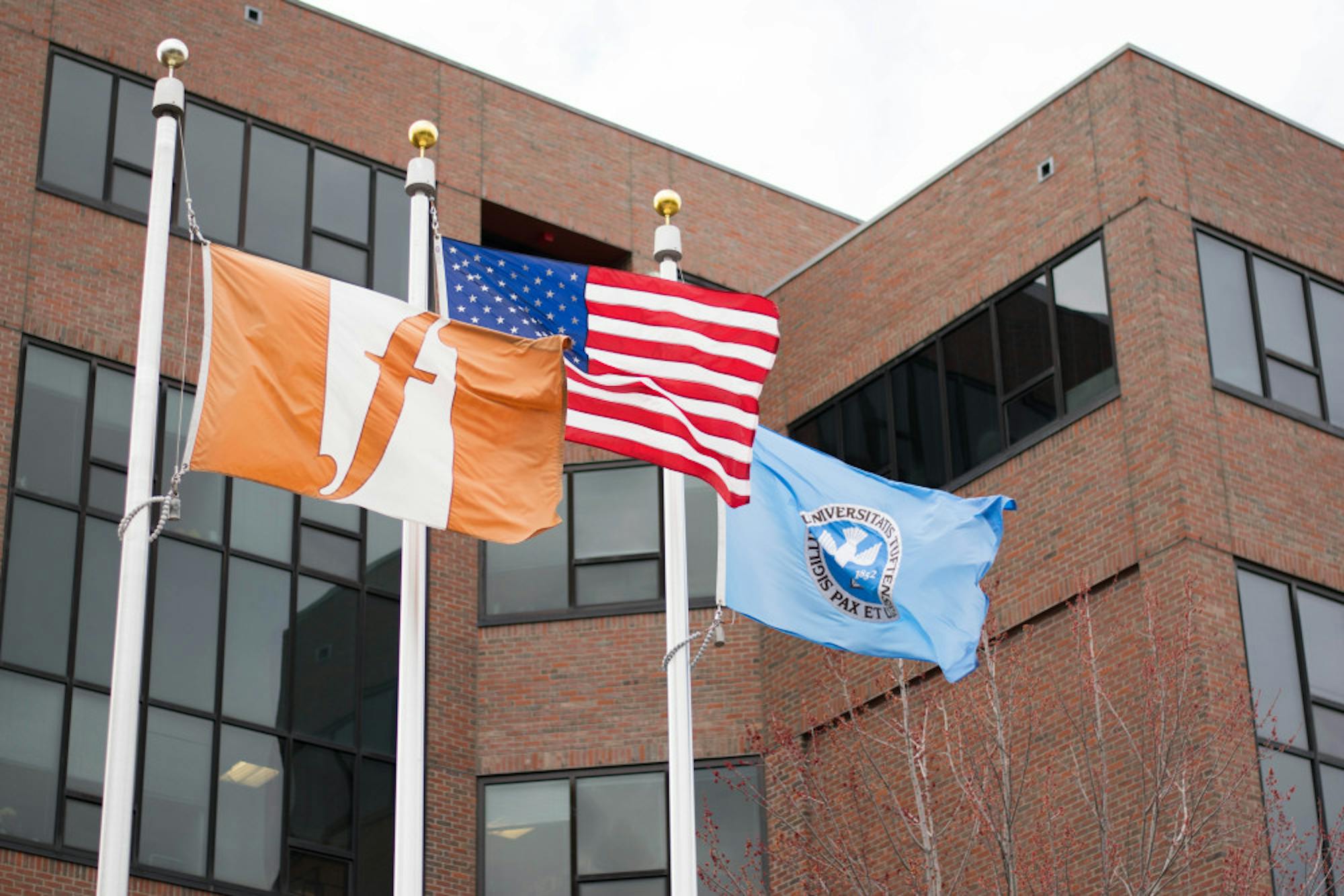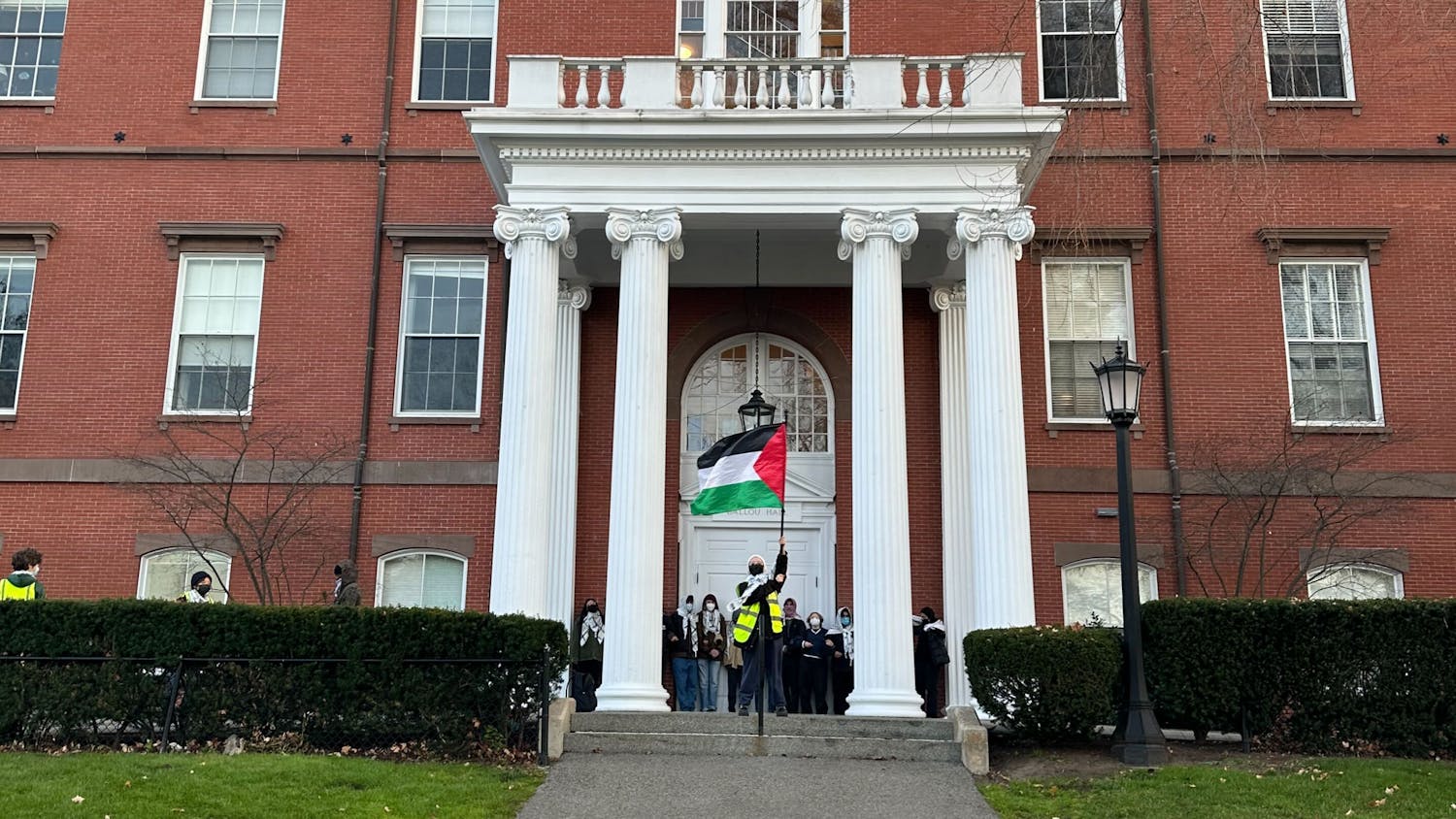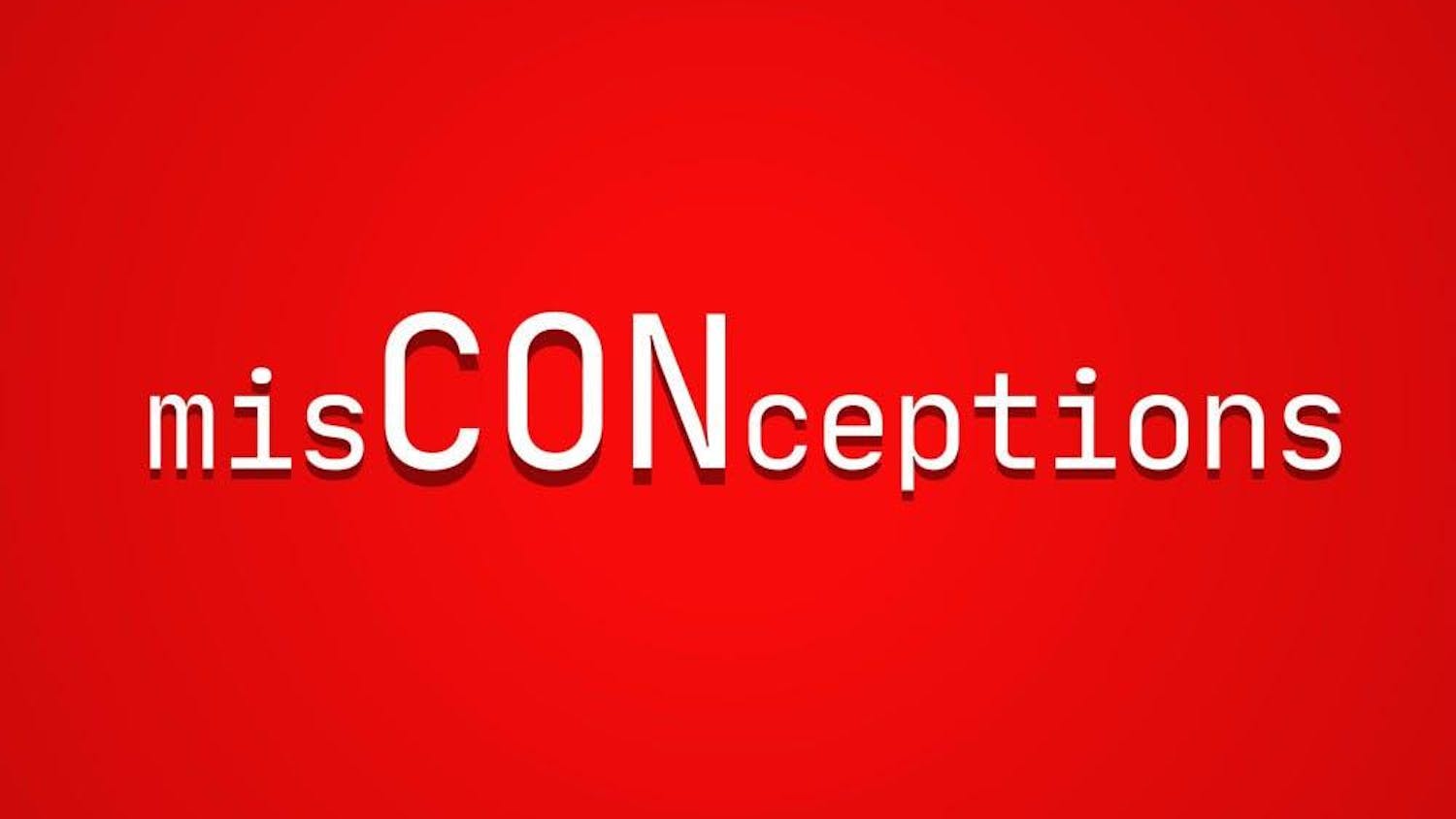Sean Ong and Jarod Gowgiel (LA’19) contributed data analysis to this article.
Tufts faculty and academic administrators donated more than $1.5 million to political campaigns and organizations between January 2015 and September 2019, with a large portion of contributions going to Democratic candidates and progressive causes, according to a review of Federal Election Commission records.
That sum comprised more than 17,000 individual contributions, made by 680 unique faculty members, over the nearly five-year period. Three faculty members were responsible for $885,000, or 57%, of all donations.
Ninety-four percent of donated money went to Democratic candidates and causes, while just under 1% went to Republican-aligned recipients. Non-partisan organizations, including those supporting independent candidates, received 4% of Tufts faculty members’ contribtions.
With such a heavy partisan skew, the Tufts faculty represented in this analysis appear to be dramatically more liberal than the Massachusetts electorate, which voted for Hillary Clinton over Donald Trump by a 27-point margin in 2016.
Tufts Provost and Senior Vice President Nadine Aubry noted that while professors may hold their own political beliefs, the university encourages students to consider a broad range of ideas.
“We expect that our faculty, staff and students will have a variety of viewpoints that they will explore in healthy and respectful debate,” Aubry told the Daily in an email. “We actively promote a diversity of voices and views, inviting people from across the ideological spectrum to speak at Tufts.”
The university’s faculty members donated far more than their contemporaries at other Northeast liberal arts colleges. During the 2016 election cycle, Tufts faculty donated over 13 times more than employees at Williams College — the next-most munificent school in the NESCAC — according to reporting by the Bowdoin Orient.
Eitan Hersh, associate professor of political science, attributed this discrepancy to the fact that Tufts is uniquely situated near a major city. This means it has more lucrative professions, offering people a greater opportunity to participate in political fundraising, according to Hersh.
“The kind of people who work here might have spouses in finance or law,” he said. “There just aren't a lot of fundraisers in rural Maine, but there are a ton in Boston, so you're much more likely to be in a social network [that encourages political donations] here.”

Political contributions by Tufts faculty have fluctuated from year to year since 2015. In the 2015–16 election cycle, 344 faculty members donated a combined $555,782 to candidates and political organizations. The following two years saw an increase in both the number and overall magnitude of donations, with 432 individuals contributing $765,268. However, the median individual’s donation fell from $200 during the 2015–16 cycle to $137.50 in the midterm cycle.
Less than a year into the 2019–20 election cycle, 269 Tufts faculty members have donated more than $228,000 to political candidates and causes, and the median donor has contributed $58.50.
This investigation reveals that a significant share of Tufts faculty from across the university’s academic institutions, departments and positions make political donations. It also examines the ideological bias that these donations indicate and its impact on the university’s scholarly mission.
Who is donating?
Faculty members at the Jonathan M. Tisch College of Civic Life and in the School of Arts and Sciences (A&S) were responsible for the majority of donated money since 2015, giving a combined $1.1 million. Together, the Tufts University School of Medicine (TUSM) and the Sackler School of Graduate Biomedical Sciences comprised the greatest number of individual donors among the university’s graduate and undergraduate schools.

Donations from faculty members in each of Tufts’ eight schools as well as two other academic institutions — the university’s administration and Tisch College — leaned overwhelmingly Democratic. Faculty in Tufts’ nutrition programs at the Friedman School of Nutrition Science and Policy and the Jean Mayer USDA Human Nutrition Research Center on Aging (HNRCA) donated exclusively to Democratic candidates and causes. Faculty members in the university’s other academic institutions were nearly as partisan; only TUSM and Sackler School faculty gave less than 95% of their contributions to Democrats.
Tufts’ largest school by enrollment, A&S includes more than 70 undergraduate degree programs and more than 60 graduate programs. A&S faculty numbered 687 in fall 2016, according to the university, making the 16% of faculty who made a political donation that year slightly higher than the 12% share of Americans who reported doing so.
From January 2015 to September 2019, A&S faculty contributed more than half a million dollars to federal candidates and political organizations, comprising 37% of Tufts faculty members’ contributions over that period.
Of the $566,462 in donations from A&S faculty, nearly all went to Democratic campaigns and progressive causes. Groups not affiliated with a political party received 1.5% of their contributions, while Republican efforts received just 0.2% of A&S faculty members’ donations.
Rachel Wolff, president of Tufts Republicans, is not surprised by the heavy liberal slant in faculty members’ political contributions.
“Tufts is known for being a fairly liberal institution, and I think that attracts more liberal-leaning professors and administrators and students,” Wolff, a senior, said.
Wolff added, however, that conservative views among the faculty may be underrepresented by looking at political donations.
“I think that people who might lean conservative would be less likely to donate to conservative candidates in case someone might see it,” she said. “Given that a conservative professor would already be in the political minority here, they might be less likely to do that.”
Faculty members at Tisch College contributed slightly more than their A&S colleagues, with $578,704 in political donations since 2015, despite having only 12 unique donors. This discrepancy is largely due to spending by Dean of Tisch College Alan Solomont, whose contributions represent nearly the entirety of donations from Tisch College faculty.
Solomont, who has spent $576,515 since 2015, primarily to bolster Democratic efforts, is the top donor among Tufts faculty. Ninety-nine percent of his contributions went to Democratic candidates and organizations, with more than $200,000 going to the Democratic Congressional Campaign Committee.
Solomont said he views his campaign contributions as a minor aspect of how he impacts civic discourse, given his work at Tisch College.
“My own personal views are not a secret,” he said. “But people ask me now who [my] candidate [is], and I tell them I don't have a candidate. What we do [at Tisch College] is study what young people are doing. That's probably a better contribution I can make to democracy today.”
TUSM and the Sackler School led all Tufts schools with 257 unique donors and boasted the most diverse apportionment of contributions. Of the nearly quarter of a million dollars donated by TUSM and Sackler School faculty, 70% went to Democratic candidates and causes, while 25% went to organizations not affiliated with a political party. TUSM and Sackler School faculty also donated $12,609 — 5% of their contributions — to Republican-aligned groups, the most from any Tufts school.
Ken Olum, a research professor in the Department of Physics and Astronomy, has given $225,420 to Democratic candidates since 2015, making him the second-highest donor at Tufts. Olum commented that faculty members in STEM fields are more insulated from political discussions than their peers in other departments.
“[Politics] doesn't arise in my work or interactions with students,” he said. “One of the nice things about physics is you don't have Republican physicists or Democrat physicists.”
Nonetheless, Olum added that he tends to avoid ideological debates with his colleagues.
“It's not the case that all the faculty here in our department have the same political views … but I don't want such conversations to interfere with our ability to work together on physics,” Olum said. “That makes me reluctant to have conversations with people with whom I know I'm going to have a disagreement.”

Faculty members in 34 departments within A&S and the School of Engineering contributed to political organizations between January 2015 and September 2019. Physics and astronomy led all departments in money donated, largely due to Olum’s contributions. Among departments with the most unique donors, however, child studies and human development (25), biology (20) and English (19) topped the list. Only two of the 223 donors in A&S and the School of Engineering contributed to Republican-aligned causes.

Tenured faculty members donated a combined $738,922 to political organizations since 2015, followed by academic administrators, who gave $595,375. The latter figure is distorted by Solomont’s contributions, however, as only 10 administrators made political donations. Eighty-eight Tufts employees engaged primarily in research donated a combined $143,443.
Where did the money go?
Donations from Tufts faculty filled the coffers of political organizations in all 50 states, as well as Washington, D.C. Candidates in New York and Massachusetts received the most money, while races in Kansas, Idaho and South Dakota garnered the least.
Tufts faculty contributed nearly $850,000 directly to candidates for federal office between January 2015 and September 2019. Candidates for the House of Representatives received 43% of those funds, followed closely by candidates for the Senate (39%).

While only 18% of donated money went to presidential candidates, Tufts faculty showed greater engagement with the presidential race than House or Senate races. Three-hundred and sixty unique donors contributed to a presidential campaign, while House and Senate campaigns received donations from 214 and 283 faculty members, respectively.
Tufts faculty members donated $168,991 to Hillary Clinton’s presidential campaign in the 2015–16 election cycle. By contrast, university faculty have given U.S. President Donald Trump a total of $2,259 between his two campaigns.
Among 2020 presidential candidates, Sen. Elizabeth Warren has received the most money from Tufts faculty members, with $17,697 in contributions, followed by South Bend, Ind., Mayor Pete Buttigieg ($6,831) and California Sen. Kamala Harris ($4,710). Tufts faculty members have donated $43,250 to Warren’s various campaigns since 2015. The progressive firebrand won re-election in 2018 before entering the 2020 presidential race.
Herd mentality in higher education?
In her remarks at the 2017 Conservative Political Action Conference, U.S. Secretary of Education Betsy DeVos warned college students to be wary of receiving undue political influence from faculty members.
“The faculty, from adjunct professors to deans, tell you what to do, what to say and, more ominously, what to think,” DeVos said.
DeVos’s comments reflect a decades-old concern in American conservatism.
Right-wing commentators have long bemoaned college campuses as bastions of liberal groupthink. William F. Buckley Jr. remarked in 1961 that he “would rather be governed by the first 2,000 people in the telephone directory than by the Harvard University faculty.”
Indeed, higher education faculty leans heavily progressive. In a 2007 study by researchers at Harvard University and George Mason University, 44.1% of professors identified as liberal, while only 9.2% identified as conservative. In the same study, 51% of professors identified as Democrats, 35.3% identified as independents and 13.7% identified as Republicans.
Moreover, the share of progressive faculty has been on the rise.
The Higher Education Research Institute at the University of California, Los Angeles has surveyed full-time faculty at U.S. colleges and universities every three years since 1989. That year, 41.7% of respondents identified as politically liberal or far-left and 40.2% identified as moderate, while 18.2% identified as conservative or far-right. In 2016, the surveyed professoriate identified as 59.8% liberal or far-left, 28.1% moderate and just 12.1% conservative or far-right.
Much of this progressive skew is concentrated in New England — where research indicates liberal professors outnumber their conservative colleagues 28 to one — as well as in the arts, humanities and social sciences.
These disciplines represent “activist scholarship” and naturally attract a more liberal faculty, according to Samuel Abrams, professor of politics at Sarah Lawrence College.
“There's been a selection mechanism where ultra-progressive people are moving more and more to a lot of these departments and programs,” Abrams said. “If you look at the last two decades or so, the programs have become less purely ‘ivory tower’ academic.”
At the same time, conservatives have become increasingly hostile toward higher education.
Thirty-eight percent of American adults believe colleges have a negative impact on the country in 2019, up from 28% in 2015, according to Pew Research Institute. This shift has largely been driven by changing attitudes among Republican and Republican-leaning independents, 59% of whom say colleges negatively impact the country — compared to 37% four years ago.
Conservatives’ antipathy to higher education appears to result from, at least in part, a mistrust of college faculty.
Nearly one in five Republican and Republican-leaning respondents in a 2018 Pew survey expressed no confidence that professors act in the public interest. Meanwhile, among respondents in a separate Pew survey who believe higher education is going in the wrong direction, 79% of Republicans blamed professors for bringing their political and social views into the classroom, while only 17% of Democrats did so.
The growing body of research examining partisanship in higher education does not reveal a concerted effort to indoctrinate students, however. Rather, Abrams said professors typically include a range of perspectives in their curricula.
“There may be a lopsided ideological personal bent [among professors], but we’re not necessarily seeing it thrust upon students that way,” Abrams said. “Students around the country are not being fed one particular line at all — they are getting balance.”
Nor does such scholarship indicate that students’ political beliefs change substantially due to faculty influence, intentional or unintentional.
A 2009 study of more than 1,500 students revealed a slight leftward shift among the students over their four years in college but found little evidence that professors’ ideologies were responsible for this shift. The study also showed that both Democrats and Republicans adopted more moderate views while in college.
Matthew Woessner, one of the study’s authors, explained that students are largely resistant to political indoctrination.
“Students aren’t sponges,” Woessner, who now serves as professor of institutional research at the United States Army War College, told the Daily. “By the time they’re 17 or 18 years old, they’ve already developed an ideological disposition that isn’t easily swayed by college professors.”
Similar research by Amy Binder, professor of sociology at the University of California, San Diego, and Kate Wood, a former doctoral candidate in that department, also found little evidence of “liberal indoctrination” on college campuses. Like Woessner, Binder and Wood observed that conservative students receive unique advantages from being educated in a left-wing milieu.
“Conservatives benefit from having liberal professors providing … a liberal perspective because it allows them to challenge their underlying beliefs,” Woessner said. “The liberal students don't get that opportunity because they have very few conservatives professors who will poke at their beliefs or challenge them.”
Abrams and Woessner stressed the need for more conservative voices among university faculty, though both reject using an ideological test or quota program to hire professors.
“The concern is that if everyone does share a worldview, those other views may just disappear,” Abrams said.
Efforts to diversify the professoriate are often hindered by right-wing narratives that vilify higher education, according to Woessner.
“Part of the problem that we have in trying to diversify our education is actually exacerbated when organizations like Fox News exaggerate the nature of the conflict,” he said. “For the most part, students on the left and the right get through college just fine.”
Nonetheless, several unsettling trends may result from partisan skew among college faculties.
Woessner’s research indicates that students who feel ideologically at-odds with a professor are less likely to have a positive learning experience in that class. Conservative students may simply avoid disciplines in which they are likely to encounter progressive faculty, according to Abrams.
“That leads to sort of this funnel and then we have this monoculture, and that's … in my opinion, the antithesis of what higher education should be about,” he said.
Evidence of an ivory tower atop the Hill
Solomont acknowledged the concern that college campuses are often echo chambers of liberal thought. However, he rejected the notion that professors imbue students with their personal views as not only false but fundamentally opposed to their academic responsibility.
“Students are here to learn and grow intellectually … and one element of learning is to be able to look at things through different lenses,” he said. “I believe faculty can teach from a variety of standpoints, regardless of what their political views are.”
Aubry explained that university employees can donate to any cause or candidate they support and that Tufts does not monitor such contributions. She highlighted the university’s Inclusive Learning Institute, an annual program organized by the Center for the Enhancement of Learning and Teaching, as one way it encourages professors to present diverse perspectives in the classroom and engage students in challenging yet productive conversations.
“A great professor — and we have great professors at Tufts — has the ability to put her or his personal views aside and present a variety of perspectives,” Aubry said. “As a university, we always strive to create an environment in which all members of our community feel free to express their opinions in or out of the classroom.”
This often requires that faculty members recognize their personal biases and consider, or even embrace, opposing viewpoints.
Peter Levine, associate dean of academic affairs at Tisch College, teaches the introductory course in Tufts’ new civic studies program. Levine explained that he works hard to understand libertarian economic theory, which includes speaking with libertarian thinkers, in order to confront his own left-leaning beliefs.
“I think it's really important for anyone who's intellectually serious to challenge themselves by wrestling with ideas that they don't agree with and by making sure they're in networks and situations where they get challenged,” Levine said.
Hersh added that uniformity among students’ political views introduces a greater risk of bias in the classroom than professors’ personal beliefs.
“Whether a faculty member who is of one party can't bring themselves to articulate, when appropriate, a worldview that is inconsistent with theirs, it's an even bigger problem in the student population,” he said. “The school needs to do a much better job recruiting an ideologically diverse student body.”
Hersh surveyed his electoral politics class this semester and found that 95% of the students identify as Democrats.
“I … work very hard to make sure they see that the other side on many of the issues that they feel strongly about is reasonable and sometimes serves their interest more than they think,” he said. “I think in politics, it's very important to cultivate a sense of empathy. It doesn't help anyone to be so dismissive of another side that you can't even understand where they're coming from.”
Conservative students appreciate professors’ efforts to challenge liberal consensus in the classroom, according to Wolff.
“When we are in classes where we might be the only conservative, that professor will a lot of times make a very concerted effort to make sure that they are … paying equal respect to conservative arguments [and] making sure the student is heard and respected,” Wolff said. “Professors can have their own political opinions that skew to the left and also be fair to arguments and students that are on the right.”
Levine acknowledged, however, that professors cannot — and should not — be completely objective in designing curricula, adding that he presents certain views, such as libertarianism, as more ideologically legitimate than others, like fascism.
“You have to exercise some judgment about what counts as a reasonable position that students should take seriously,” Levine said. “I try to be transparent about what my own views are when they might be relevant and also why we're reading things ... Are we reading them because they challenge our … view, [or] are we reading them because they're actually bad things in the world that we should learn to confront?”
Levine explained that rather than pushing any particular view as correct, he encourages students to grapple with ideas they find uncomfortable.
As Wolff often finds herself among the ideological minority at Tufts, she has frequent opportunities to do so. Consistent with the scholarship on classroom politics, she noted that these incidents have strengthened her personal views.
“It’s been a great experience being a conservative on this campus with more liberal-leaning professors, just in the sense that it’s challenged me on a lot of issues,” Wolff said. “I think if I was surrounded by conservatives all the time, I would be stuck in the exact same echo chamber that a lot of the liberal-leaning students here are stuck in.”
Nonetheless, she expressed support for having a greater range of views in academia and suggested that Tufts promote ideological representation among its faculty as it would other academic qualifications and forms of diversity.
“Academia is basically this constant discourse [between professors] pushing back on one another, and I think that's hard to do when you don't have a politically diverse faculty,” Wolff said.
The university does not currently consider candidates’ political beliefs in the faculty hiring process, according to Aubry.
Levine believes that a professor’s ideology is a personal matter and should be kept out of hiring decisions. Moreover, he cautioned that political donations may not accurately represent someone’s beliefs, which are likely more nuanced than any one candidate or cause represents, nor do they necessarily betray a political slant in their teaching.
“I don't jump to the conclusion that because a lot of faculty contribute to Democratic candidates, they are ideologically biased in the classroom,” he said. “It’s the kind of thing that you should reflect on, as a professor, because we all ought to be committed to intellectual diversity … but I think it’s just the beginning of a conversation about what ideas fit in which classes and how to present them.”
Methodology
The Daily analyzed the federal political donations of 680 individual contributors who reported Tufts or one of its constituent schools as their employer and were listed in Tufts White Pages or on university websites as researchers, administrators overseeing academic and research programs, or faculty members. This includes staff who hold adjunct and visiting positions or who have left or retired from Tufts since January 2015.
This data excluded political donations from the Board of Trustees, student employees and other Tufts employees whose work does not directly influence academic or research programs. Donations from staff members with appointments at multiple schools or departments at Tufts only counted toward the data of the school or department at which they have their primary appointments.
The data set, available publicly from the Federal Election Commission (FEC), comprised 17,060 donations from January 2015 to September 2019 made to 556 authorized committees, political parties and political action committees (PACs), including so-called "super PACs." The data did not include donations to tax-exempt nonprofits that are not required to disclose any donor information, including 501(c)(4) organizations. Earmarked donations only counted toward the final recipient and not the intermediary committee.
Information on committees’ party affiliations and geographical locations were obtained from the FEC and the Center for Responsive Politics’ website, OpenSecrets.org. Information on donors’ titles, school affiliations and departments came from the Tufts directory and university websites. Data collection and analysis were conducted in Microsoft Excel and Python.






